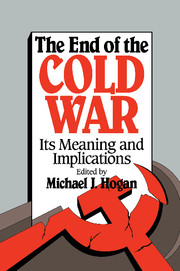Book contents
- Frontmatter
- Contents
- Preface
- The Authors
- Dedication
- 1 Introduction
- 2 An End to Which Cold War?
- 3 The Cold War, the Long Peace, and the Future
- 4 Quiet Cataclysm: Some Afterthoughts on World War III
- 5 Some Lessons from the Cold War
- 6 Nuclear Weapons and European Security during the Cold War
- 7 Victory in the Postwar Era: Despite the Cold War or Because of It?
- 8 The Wicked Witch of the West is Dead. Long Live the Wicked Witch of the East
- 9 The End and the Begining
- 10 A Balance Sheet: Lippmann, Kennan, and the Cold War
- 11 Why Did the Cold War Arise, and Why Did It End?
- 12 A View from Below
- 13 The End of the Cold War and the Middle East
- 14 The End of the Cold War in the Near East: What It Means for Historians and Policy Planners
- 15 After the Cold War: The United States, Germany, and European Security
- 16 The End of the Cold War: A Skeptical View
- 17 The End of the Cold War, the New Role for Europe, and the Decline of the United States
- 18 The Fading of the Cold War—and the Demystification of Twentieth-Century Issues
- 19 The U.S. Government, a Legacy of the Cold War
- 20 Foreign Policy, Partisan Politics, and the End of the Cold War
- 21 Beyond Bipolarity in Space and Time
- 22 A Usable Past for the Future
- Selective Bibliography
- Index
8 - The Wicked Witch of the West is Dead. Long Live the Wicked Witch of the East
Published online by Cambridge University Press: 18 December 2009
- Frontmatter
- Contents
- Preface
- The Authors
- Dedication
- 1 Introduction
- 2 An End to Which Cold War?
- 3 The Cold War, the Long Peace, and the Future
- 4 Quiet Cataclysm: Some Afterthoughts on World War III
- 5 Some Lessons from the Cold War
- 6 Nuclear Weapons and European Security during the Cold War
- 7 Victory in the Postwar Era: Despite the Cold War or Because of It?
- 8 The Wicked Witch of the West is Dead. Long Live the Wicked Witch of the East
- 9 The End and the Begining
- 10 A Balance Sheet: Lippmann, Kennan, and the Cold War
- 11 Why Did the Cold War Arise, and Why Did It End?
- 12 A View from Below
- 13 The End of the Cold War and the Middle East
- 14 The End of the Cold War in the Near East: What It Means for Historians and Policy Planners
- 15 After the Cold War: The United States, Germany, and European Security
- 16 The End of the Cold War: A Skeptical View
- 17 The End of the Cold War, the New Role for Europe, and the Decline of the United States
- 18 The Fading of the Cold War—and the Demystification of Twentieth-Century Issues
- 19 The U.S. Government, a Legacy of the Cold War
- 20 Foreign Policy, Partisan Politics, and the End of the Cold War
- 21 Beyond Bipolarity in Space and Time
- 22 A Usable Past for the Future
- Selective Bibliography
- Index
Summary
What was the Cold War? Ostensibly it was a global struggle between communism and democracy, with frightening military formations arrayed along the central front in Europe. Three “Berlins” seemed to typify the conflict and to place the appropriate emphasis on Europe: the airlift in 1948 at the Cold War's reported begining, the crisis in 1961 that summed up its bipolar and intractable nature, and the dismantling of the wall in 1989 that presumably ended it. Hardly any lives were lost along the central axis of division in Europe, which encourages historians like John Lewis Gaddis to speak of a “long peace” in our time. Gaddis argues for the success of George Kennan's containment doctrine, conceived as a long twilight struggle to hold the existing lines of the postwar settlement, until the Soviet Union saw the error of its ways and reformed itself. When Gorbachev proceeded to dismantle the Soviet empire, Kennan's wisdom seemed triumphant. Only a myopic Eurocentrism could yield such conclusions.
In fact, Europe fought a “shadow conflict,” obscuring the real history of the past four decades. Kennan's strategy had a curiosity in an unspoken premise: The doctrine was meant both to contain the enemy, the Soviet Union, and the allies—mainly West Germany and Japan. Kennan was one of the architects of a strategy in which West Germany and Japan were shorn of their previous military and political clout during the period of American occupation, but their industrial economies were encouraged to revive, and they were posted as engines of growth in the world economy.
- Type
- Chapter
- Information
- The End of the Cold WarIts Meaning and Implications, pp. 87 - 102Publisher: Cambridge University PressPrint publication year: 1992
- 6
- Cited by



